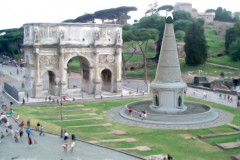A word for Sunday about sweat - from Roma sudans
The Last Supper, the Eucarist, was initially celebrated in the cool evening, but very soon alternatively in the early morning, in any case never in the heat of midday. Now we understand why. Christianity is a Mediterranean religion, so the warm climate plays a role.
In fact, the well-known Reallexikon für Antike und Christentum did not hesitate to offer a keyword "sweat", and there we learn that for the ancient Greeks and Romans sweat and tears were, so to speak, the same thing: the tears that roll out of the eyes and the drops of sweat on the skin are twins, but in different aggregate states: tears are more fluid than sweat.
Even liturgy has dealt with tears. As early as the days of Charlemagne, there was the votive mass pro dono lacrimarum - the prayer for the flow of tears. Because weeping over one's sins was a sign of genuine repentance, it was a problem if one could not weep. Even if one had a problem crying otherwise, such as when the Pope died, then one needed the Mass of Tears. Unfortunately, the recent liturgical reform did away with the Mass of Tears.
On the other hand, there was never a votive Mass for weeping in the missal. That is strange. After all, there are enough people who suffer from laziness. A mass for sweaty zeal would be quite appropriate. But nobody wants sweat.
In the history of salvation, sweat even carries the smell of sin. As is well known, the Fall of Man ends in sweat: as punishment, Adam is told: "In the sweat of your face you shall eat your bread". Conversely, sweat is also the price of salvation: Jesus on the Mount of Olives sweats so much that the sweat drips down from his face and is red like blood (Lk 22:44). The sweat of Adam is redeemed by the sweat of the new Adam. Jesus' sweating of blood in the Garden of Gethsemane, that is, sweating to the point of blood, is also connected to the ancient idea that sweat, just like tears, is diluted blood.
Finally, the sweat cloth plays a major role in the New Testament: the soudarion. The sudarium was placed on the face of the dead. When Lazarus came out of the tomb, his face was covered with a sweat cloth (Jn 11:44). And Jesus' face was also covered with the face-cloth (Jn 20:7). Perhaps this was done symbolically: the dead man who had cooled down was released from his work and sweat. He has found his rest. Even more so after Easter: the one who died in Christ is redeemed from the sweat of Adam's sin.
The sudarium appears one last time in the New Testament in the Acts of the Apostles (Acts 19:12). The apostle Paul is on a missionary journey in Ephesus. Obviously he worked up quite a sweat. They even tore the sudarium from his body and put it on the sick. Then the illnesses disappeared and the evil spirits left. So Paul's sweat cloths were already used like contact relics during his lifetime. So sweat can also have its good side.
What else do you think of when you sweat? Here in blisteringly hot Rome, perhaps the Meta Sudans at Constantine's Arch - but you will already know what that is all about.
- Details
- Written by: Stefan Heid
- Category: Roman notes
 Römisches Institut der Görres-Gesellschaft
Römisches Institut der Görres-Gesellschaft







